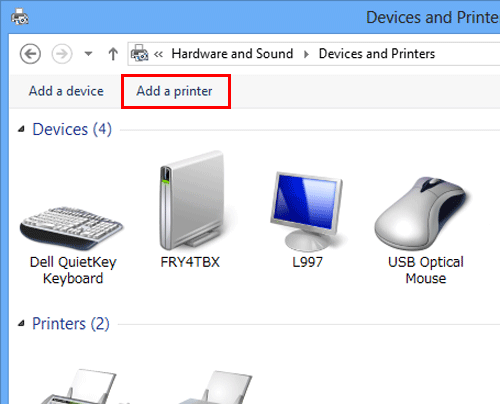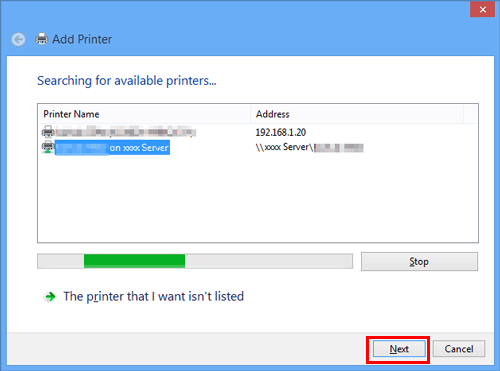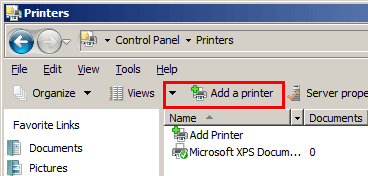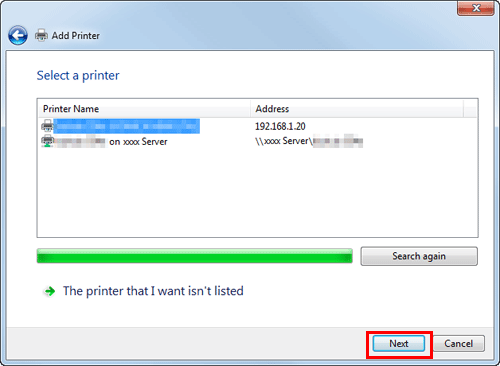Installation Using a SMB Connection
Operations required to use this function (For administrators)
Configure the SMB operating environment.
How to configure the setting is explained using Web Connection. For details, refer to [Configuring the SMB printing environment] .
In Windows 8.1/10/Server 2012/Server 2012 R2/Server 2016
You can install the printer driver by automatically detecting the printer on the network or by creating a new port.
 Administrator privileges are required to perform this task.
Administrator privileges are required to perform this task.
 Since the printer is searched for during the installation, be sure to connect this machine to the network before turning it on.
Since the printer is searched for during the installation, be sure to connect this machine to the network before turning it on.
Insert the printer driver DVD into the DVD drive of the computer.
Display the printer window.
 In Windows 8.1/10, while pressing the [Windows] (
In Windows 8.1/10, while pressing the [Windows] ( ) key, press the [X] key, and then click [Control Panel] - [Hardware and Sound] - [View devices and printers] in the displayed menu.
) key, press the [X] key, and then click [Control Panel] - [Hardware and Sound] - [View devices and printers] in the displayed menu. In Windows Server 2012/Server 2012 R2/Server 2016, while pressing the [Windows] (
In Windows Server 2012/Server 2012 R2/Server 2016, while pressing the [Windows] ( ) key, press the [X] key, and then click [Control Panel] - [Hardware] - [View devices and printers] in the displayed menu.
) key, press the [X] key, and then click [Control Panel] - [Hardware] - [View devices and printers] in the displayed menu.Select Add a printer.

The [Add Printer] Wizard appears.
Select your machine from the list, then click [Next].
 If no printers are detected, restart this machine.
If no printers are detected, restart this machine. Select a printer from "\\NetBIOS-name\print-service-name".
Select a printer from "\\NetBIOS-name\print-service-name".
To check the NetBIOS name and print service name, select [Utility] - [Administrator Settings] - [Network Settings] - [SMB Settings] - [SMB Server Settings] - [SMB Print Setting] on this machine. It may take some time to finish searching the entire list of printers.
It may take some time to finish searching the entire list of printers.
Click [OK].
Click [Have Disk...].
Click [Browse...].
Select the folder on the DVD containing the desired printer driver, then click [Open].
 Select the folder according to the printer driver, operating system, and language to be used.
Select the folder according to the printer driver, operating system, and language to be used.
Selectable printer drivers: PCL driver, PS driver, and XPS driverClick [OK].
The [Printers] list appears.
Click [Next].
Follow the instructions on the pages that follow.
 If the [User Account Control] window appears, click [Continue] or [Yes].
If the [User Account Control] window appears, click [Continue] or [Yes].Click [Finish].
After finishing the installation, make sure that the icon for the installed printer is displayed in the [Devices and Printers] window.
Eject the DVD from the DVD drive.
This completes the installation process of the printer driver.
The procedure for installing the printer driver by creating a new port is as follows:
 Administrator privileges are required to perform this task.
Administrator privileges are required to perform this task.
 Since the printer is searched for during the installation, be sure to connect this machine to the network before turning it on.
Since the printer is searched for during the installation, be sure to connect this machine to the network before turning it on.
Insert the printer driver DVD into the DVD drive of the computer.
Display the printer window.
 In Windows 8.1/10, while pressing the [Windows] (
In Windows 8.1/10, while pressing the [Windows] ( ) key, press the [X] key, and then click [Control Panel] - [Hardware and Sound] - [View devices and printers] in the displayed menu.
) key, press the [X] key, and then click [Control Panel] - [Hardware and Sound] - [View devices and printers] in the displayed menu. In Windows Server 2012/Server 2012 R2/Server 2016, while pressing the [Windows] (
In Windows Server 2012/Server 2012 R2/Server 2016, while pressing the [Windows] ( ) key, press the [X] key, and then click [Control Panel] - [Hardware] - [View devices and printers] in the displayed menu.
) key, press the [X] key, and then click [Control Panel] - [Hardware] - [View devices and printers] in the displayed menu.Select Add a printer.

In the window showing the detected printer, click [The printer that I want isn't listed].
Click [Add a local printer or network printer with manual settings].
Click [Create a new port:], then select [Local Port].
Click [Next].
Specify the IP address and port.
 Enter "\\NetBIOS-name\print-service-name" in the [Port Name] box.
Enter "\\NetBIOS-name\print-service-name" in the [Port Name] box. To enter the NetBIOS name and print service name, select [Utility] - [Administrator Settings] - [Network Settings] - [SMB Settings] - [SMB Server Settings] - [SMB Print Setting] on this machine.
To enter the NetBIOS name and print service name, select [Utility] - [Administrator Settings] - [Network Settings] - [SMB Settings] - [SMB Server Settings] - [SMB Print Setting] on this machine.Click [OK].
Click [Have Disk...].
Click [Browse...].
Select the folder on the DVD containing the desired printer driver, then click [Open].
 Select the folder according to the printer driver, operating system, and language to be used.
Select the folder according to the printer driver, operating system, and language to be used.
Selectable printer drivers: PCL driver, PS driver, and XPS driverClick [OK].
The [Printers] list appears.
Click [Next].
Follow the instructions on the pages that follow.
 If the [User Account Control] window appears, click [Continue] or [Yes].
If the [User Account Control] window appears, click [Continue] or [Yes].Click [Finish].
After finishing the installation, make sure that the icon for the installed printer is displayed in the [Devices and Printers] window.
Eject the DVD from the DVD drive.
This completes the installation process of the printer driver.
In Windows 7/Server 2008/Server 2008 R2
You can install the printer driver by automatically detecting the printer on the network or by creating a new port.
The procedure for installing the printer driver by automatically detecting the printer on the network is as follows:
 Administrator privileges are required to perform this task.
Administrator privileges are required to perform this task.
 Since the printer is searched for during the installation, be sure to connect this machine to the network before turning it on.
Since the printer is searched for during the installation, be sure to connect this machine to the network before turning it on.
Insert the printer driver DVD into the DVD drive of the computer.
Display the printer window.
 In Windows 7/Server 2008 R2, click the Start menu, then click [Devices and Printers].
In Windows 7/Server 2008 R2, click the Start menu, then click [Devices and Printers].
If [Devices and Printers] is not displayed, select [Control Panel] - [Hardware and Sound], and click [View devices and printers]. When [Control Panel] is displayed in an icon view, double-click [Devices and Printers]. In Windows Server 2008, click the Start menu, then click [Control Panel] - [Hardware and Sound] - [Printers]. When [Control Panel] is displayed in Classic View, double-click [Printers].
In Windows Server 2008, click the Start menu, then click [Control Panel] - [Hardware and Sound] - [Printers]. When [Control Panel] is displayed in Classic View, double-click [Printers].Select Add a printer.
 In Windows 7/Server 2008 R2, click [Add a printer].
In Windows 7/Server 2008 R2, click [Add a printer].
 In Windows Server 2008, click [Add a printer].
In Windows Server 2008, click [Add a printer].
The [Add Printer] Wizard appears.
Click [Add a network, wireless or Bluetooth printer].
Connected printers are detected.
Select your machine from the list, then click [Next].
 If no printers are detected, restart this machine.
If no printers are detected, restart this machine. Select a printer from "\\NetBIOS-name\print-service-name".
Select a printer from "\\NetBIOS-name\print-service-name".
To check the NetBIOS name and print service name, select [Utility] - [Administrator Settings] - [Network Settings] - [SMB Settings] - [SMB Server Settings] - [SMB Print Setting] on this machine. It may take some time to finish searching the entire list of printers.
It may take some time to finish searching the entire list of printers.
Click [OK].
Click [Have Disk...].
Click [Browse...].
Select the folder on the DVD containing the desired printer driver, then click [Open].
 Select the folder according to the printer driver, operating system, and language to be used.
Select the folder according to the printer driver, operating system, and language to be used.
Selectable printer drivers: PCL driver, PS driver, and XPS driverClick [OK].
The [Printers] list appears.
Click [Next].
Follow the instructions on the pages that follow.
 If the [User Account Control] window appears, click [Continue] or [Yes].
If the [User Account Control] window appears, click [Continue] or [Yes].Click [Finish].
After finishing the installation, make sure that the icon for the installed printer is displayed in the [Printers] or [Devices and Printers] window.
Eject the DVD from the DVD drive.
This completes the installation process of the printer driver.
The procedure for installing the printer driver by creating a new port is as follows:
 Administrator privileges are required to perform this task.
Administrator privileges are required to perform this task.
 Since the printer is searched for during the installation, be sure to connect this machine to the network before turning it on.
Since the printer is searched for during the installation, be sure to connect this machine to the network before turning it on.
Insert the printer driver DVD into the DVD drive of the computer.
Display the printer window.
 In Windows 7/Server 2008 R2, click the Start menu, then click [Devices and Printers].
In Windows 7/Server 2008 R2, click the Start menu, then click [Devices and Printers].
If [Devices and Printers] is not displayed, select [Control Panel] - [Hardware and Sound], and click [View devices and printers]. When [Control Panel] is displayed in an icon view, double-click [Devices and Printers]. In Windows Server 2008, click the Start menu, then click [Control Panel] - [Hardware and Sound] - [Printers]. When [Control Panel] is displayed in Classic View, double-click [Printers].
In Windows Server 2008, click the Start menu, then click [Control Panel] - [Hardware and Sound] - [Printers]. When [Control Panel] is displayed in Classic View, double-click [Printers].Select Add a printer.
 In Windows 7/Server 2008 R2, click [Add a printer].
In Windows 7/Server 2008 R2, click [Add a printer].
 In Windows Server 2008, click [Add a printer].
In Windows Server 2008, click [Add a printer].
The [Add Printer] Wizard appears.
Click [Add a local printer].
The [Choose a printer port] dialog box appears.
Click [Create a new port:], then select [Local Port].
Click [Next].
Specify the IP address and port.
 Enter "\\NetBIOS-name\print-service-name" in the [Port Name] box.
Enter "\\NetBIOS-name\print-service-name" in the [Port Name] box. To enter the NetBIOS name and print service name, select [Utility] - [Administrator Settings] - [Network Settings] - [SMB Settings] - [SMB Server Settings] - [SMB Print Setting] on this machine.
To enter the NetBIOS name and print service name, select [Utility] - [Administrator Settings] - [Network Settings] - [SMB Settings] - [SMB Server Settings] - [SMB Print Setting] on this machine.Click [Next].
 If the [More Port Information Required] window appears, go to Step 9.
If the [More Port Information Required] window appears, go to Step 9. If the [Install the printer driver] dialog box appears, go to Step 12.
If the [Install the printer driver] dialog box appears, go to Step 12.Select the [Custom] check box, then click [Settings...].
Change the settings according to the port, and then click [OK].
Click [Next] or [OK].
The [Install the printer driver] dialog box appears.
Click [Have Disk...].
Click [Browse...].
Select a desired printer driver folder in the DVD, and then click [Open].
 Select the folder according to the printer driver, operating system, and language to be used.
Select the folder according to the printer driver, operating system, and language to be used.
Selectable printer drivers: PCL driver, PS driver, and XPS driverClick [OK].
The [Printers] list appears.
Click [Next].
Follow the instructions on the pages that follow.
 If the [User Account Control] window appears, click [Continue] or [Yes].
If the [User Account Control] window appears, click [Continue] or [Yes].Click [Finish].
After finishing the installation, make sure that the icon for the installed printer is displayed in the [Printers] or [Devices and Printers] window.
Eject the DVD from the DVD drive.
This completes the installation process of the printer driver.